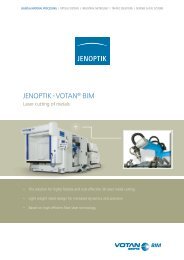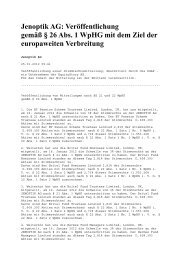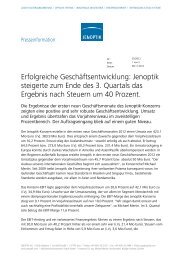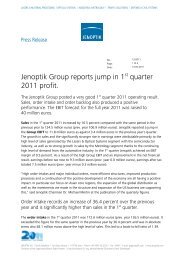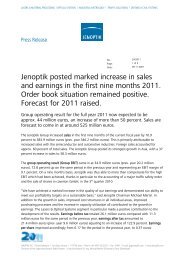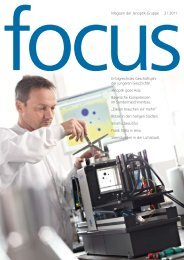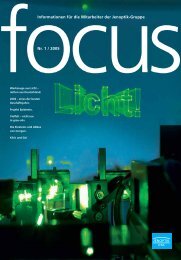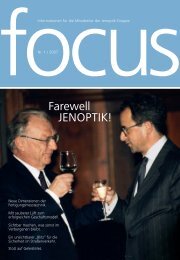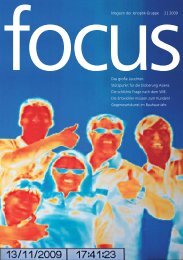normal - Jenoptik AG
normal - Jenoptik AG
normal - Jenoptik AG
You also want an ePaper? Increase the reach of your titles
YUMPU automatically turns print PDFs into web optimized ePapers that Google loves.
focus<br />
Magazine of the <strong>Jenoptik</strong> Group 1 l 2012<br />
Positive results and a view abroad.<br />
Unplanned stroke of genius.<br />
Everything <strong>normal</strong>.<br />
Clear view for rescue personnel.<br />
The galloping elephant.<br />
The link between popcorn and clean air.<br />
Handiwork meets high-tech.<br />
1
2<br />
Content<br />
4<br />
8<br />
12<br />
16<br />
Positive results and a view<br />
abroad.<br />
Fiscal year 2011 and the first quarter<br />
of 2012 were successful for <strong>Jenoptik</strong>.<br />
Together with the new Financial Director,<br />
<strong>Jenoptik</strong> Chairman Michael Mertin is setting<br />
the agenda for 2012.<br />
Unplanned stroke of genius.<br />
<strong>Jenoptik</strong> and the Fraunhofer Institute IOF<br />
are emulating moth’s eyes with plasma<br />
etching and succeed in developing the<br />
almost perfect antireflective coating for<br />
optics in medical and industrial technologies.<br />
Everything <strong>normal</strong>.<br />
In cooperation with the Federal Physical-<br />
Technical Institute, <strong>Jenoptik</strong> has developed<br />
a camshaft standard which will markedly<br />
improve quality control in the automotive<br />
industry.<br />
Clear view for people saving<br />
lives.<br />
Thermal images support rescue personnel<br />
in their operations. <strong>Jenoptik</strong> is manufacturing<br />
infrared sensors for the camera<br />
module of Dräger. Recently, <strong>Jenoptik</strong> was<br />
awarded the Dräger Supplier Award for<br />
this cooperation.
20<br />
24<br />
28<br />
LEGAL NOTICE<br />
Publisher:<br />
JENOPTIK <strong>AG</strong>, Public Relations<br />
07739 Jena<br />
Phone + 49 3641 65-2255<br />
Fax + 49 3641 65-24 84<br />
Responsible: Katrin Lauterbach<br />
Editors: Katrin Lauterbach, Silvia Scharlock<br />
Editorial assistance:<br />
Cornelia Ehrler, Jana Dichelle<br />
The galloping elephant.<br />
The Indian automotive market is booming.<br />
Next to many automotive manufacturers,<br />
the <strong>Jenoptik</strong> Industrial Metrology division<br />
is present onsite in the growth market<br />
India.<br />
The link between popcorn and<br />
clean air.<br />
Together with the University of Jena,<br />
<strong>Jenoptik</strong> has developed an exhaust purification<br />
system using microwave radiation<br />
that is much more efficient than any other<br />
system on the market.<br />
Handiwork meets high-tech.<br />
With the 39th edition of their “tangent”<br />
arts exhibition, <strong>Jenoptik</strong> presents fiber<br />
optic plastics and drawings by the American<br />
artist Yvette Kaiser Smith under the<br />
title “Etudes from Pi”.<br />
Pictures:<br />
<strong>Jenoptik</strong><br />
fotolia.com (page 5, 7, 8, 16, 20/21, 23, 24/25 at the<br />
top)<br />
Yvette Kaiser Smith (page 29–31)<br />
Layout: Bernd Adam, Jena<br />
Print: Druckhaus Gera GmbH<br />
The contents of this magazine address men<br />
and women equally. For better readibility, the<br />
masculine forms are used <strong>normal</strong>ly.<br />
Publication in: June 2012.<br />
3
4<br />
Fiscal year 2011 and the first quarter were both successful for <strong>Jenoptik</strong>. “This is an incentive<br />
to continue the path we have been taking.” Michael Mertin, CEO of JENOPTIK <strong>AG</strong>,<br />
is building on a future as a globally active company. “A lot will have to change,” he says,<br />
describing <strong>Jenoptik</strong>’s future development, which he will now approach together with his<br />
new colleague on the board, Rüdiger Andreas Günther, and all the staff of the Group.<br />
The main objective is to open up international markets and orient internal processes<br />
precisely towards them.<br />
Katrin Lauterbach<br />
results<br />
Positive<br />
view<br />
and a<br />
The figures published by <strong>Jenoptik</strong> in March, 2012, at the balance<br />
sheet press conference, are not bad. Sales rose by 13.5 percent<br />
to 543.3 million euros, while operating profit (group EBIT) rose by<br />
just about 70 percent to 49.2 million euros. With these results and<br />
the trends in stock prices over the past year, <strong>Jenoptik</strong> CEO Michael<br />
Mertin came second in the CEO ranking of the Wirtschaftwoche<br />
magazine. Michael Mertin and his colleague on the board, Rüdiger<br />
Andreas Günther, see no reason to slow down. “We have to<br />
become a global player and open up foreign markets. This is the<br />
only way we can continue our profitable growth in the future.”<br />
<strong>Jenoptik</strong> is primarily relying on organic growth. “Of course, we are<br />
also looking for possible acquisitions, especially in North America<br />
and Asia. But under no circumstances would we make those at<br />
any price.”<br />
To lay the foundations for growth, <strong>Jenoptik</strong> is investing in new<br />
structures and optimizing and expanding production. The investment<br />
volume in 2011, at 25 million euros, was just about 70 percent<br />
higher than in 2010. Investments will be continued – for example<br />
in Berlin, with the expansion of production capacity for the<br />
fabrication of the base material for diode lasers and in Altenstadt<br />
in Bavaria for improvements to the production of energy systems<br />
in higher power classes. But also the regional presences of the<br />
Group and thus the sales structure will be greatly reinforced. “Our<br />
strategy of building our own structures in target markets and thus<br />
achieving proximity to the customer is starting to take hold,” summarizes<br />
the <strong>Jenoptik</strong> CEO.<br />
“Close to the customer, that’s the rule.”<br />
(Michael Mertin)<br />
Since May, <strong>Jenoptik</strong> has expanded its “global footprint”, as Mertin<br />
puts it, by two more important countries. First, from Singapore,<br />
the Industrial Metrology division will be expanding its business<br />
in Southeast Asia. This division is also in the process of starting<br />
with its own structures in South America. “With one division, we<br />
are building a presence on-site that will then be available to other<br />
divisions as well.” According to Mertin, this is especially a decisive<br />
advantage over the competition in high-tech industries, which is<br />
sometimes smaller and cannot fall back on global group structures.<br />
That brings speed, flexibility, and finally also advantages in<br />
cost – first while opening up a market and then during administration.<br />
The fact that the Industrial Metrology division often plays
abroad.<br />
a pioneering role within <strong>Jenoptik</strong> is no accident. This division<br />
started with internationalization early on because it primarily provides<br />
to the global automobile industry. “Close to the customer,<br />
that’s the rule.”<br />
Sales by region<br />
America<br />
€ 25.4 m<br />
The <strong>Jenoptik</strong> locations, subsidiaries, and sales partners are in countries that are highlighted in blue.<br />
In the first quarter of 2012, <strong>Jenoptik</strong> could record an increase<br />
in sales in all markets outside Europe.<br />
America: sales in the NAFTA region plus 49.1 percent<br />
Germany: slight increase of 5.1 percent<br />
Europe: total sales minus 3.1 percent, declining business with European semiconductor customers<br />
Asia/Pacific: further growth<br />
Middle East/Africa: strongly dependent on single orders/projects<br />
The concept pays off – the business figures prove it. <strong>Jenoptik</strong><br />
saw 60 percent of sales in 2011 abroad. In the growth region of<br />
Asia, <strong>Jenoptik</strong> saw sales rise in 2011 by 55 percent over 2010; in<br />
dollars in America there was growth of around 20 percent. In<br />
both regions, sales in the next few years should rise significantly –<br />
both in absolute terms as well as in relation to total sales. “We’ve<br />
Europe<br />
€ 41.5 m<br />
Germany<br />
€ 50.5 m<br />
Middle East/Africa<br />
€ 7.3 m<br />
Asia/Pacific<br />
€ 13.0 m<br />
5
6<br />
JOE – internal program started for the harmonization of the process landscape.<br />
The goal is to have a common ERP throughout the <strong>Jenoptik</strong> Group. ERP<br />
stands for Enterprise Resource Planning and secures the efficient use of<br />
all enterprise resources and, thus, optimal business processes, based on a<br />
shared database.<br />
JOE = <strong>Jenoptik</strong> One ERP.<br />
An ERP system will now model and support all the processes of the <strong>Jenoptik</strong><br />
Group. From the historical situation, there are still different systems in use in<br />
got plenty of room above us in these regions,” says CEO Mertin.<br />
<strong>Jenoptik</strong> proved that again in the first quarter of 2012, with sales<br />
from the NAFTA region about 50 percent above those from the<br />
same period in the previous year. Especially the Industrial Metrology<br />
and Defense & Civil Systems divisions saw sharply increased<br />
sales in North America.<br />
“With our investment in research and development,<br />
in our sales structures and the expansion<br />
of our production capacity, we are investing in<br />
our own future.”<br />
(Michael Mertin)<br />
Over the course of the current fiscal year, <strong>Jenoptik</strong> is continuing<br />
this positive trend. Sales in the first quarter of 2012 were over<br />
ten percent higher than in the previous year, with operating<br />
profit reaching previous year’s level. The drop in margin in the<br />
first quarter of 2012 was due to a changed sales mix, but also to<br />
higher investment in research and development, in sales structures,<br />
and in expansion of production capacity. “We are investing<br />
in our own future,” says Mertin. On the sales side, business with<br />
the semiconductor industry fell in the first months of the year, but<br />
less severely than had been expected. <strong>Jenoptik</strong> partly compensated<br />
for the drop with stronger systems business, that is, orders<br />
with a high portion of value creation, and new key customers<br />
the <strong>Jenoptik</strong> Group. To convert to a uniform system, the advance harmonization<br />
of data and thus processes is essential. The structuring of the future<br />
process landscape, as well as the economic analysis, were concluded<br />
successfully in 2012.<br />
Teams are currently working out the future process landscape and the basics<br />
of the system that will be introduced step-by-step in the operational areas<br />
of <strong>Jenoptik</strong> starting in mid-2013. The pioneers are the Lasers & Material<br />
Processing and Optical Systems divisions, who will first make the move to<br />
the new platform. The basis will be SAP, with which all <strong>Jenoptik</strong> departments<br />
around the world will be able to work. About 200 <strong>Jenoptik</strong> staff from five<br />
divisions, Shared Services, and Corporate Center participate in the project.<br />
from other industries, for example with orders for optical systems<br />
for the Asian flat screen monitor industry and for optoelectronic<br />
systems. For example, the collaboration with Dräger was recently<br />
strengthened here. The <strong>Jenoptik</strong> Optical Systems division is also<br />
now working with the Lübeck company, with a corresponding<br />
cooperation agreement concluded in February 2012 for three<br />
years. One successful product from the collaboration with Dräger<br />
and <strong>Jenoptik</strong> sensor technology is already successful on the market.<br />
The thermal imaging camera for firefighters, the Dräger UCF<br />
7000. <strong>Jenoptik</strong> provides the camera module for this camera, and<br />
was awarded the Dräger Innovation Award in 2012 for this module.<br />
You can read more about the camera and <strong>Jenoptik</strong>’s thermal<br />
image know-how on page 16 of this brochure.<br />
“On the order side, our main target during<br />
this kind of growth is on delivery capacity and<br />
reliability.” (Michael Mertin)<br />
The trust of customers is demonstrated in order receipts in 2011,<br />
which at 650 million euros was about 20 percent higher than<br />
in 2010. This also included several large orders, primarily for<br />
the Traffic Solutions and Defense & Civil Systems divisions. The<br />
good order climate continued in the first quarter of 2012. The<br />
Traffic Solutions division was able to win another large order.<br />
For Malaysia, the division will deliver traffic safety systems and
services valued at over 40 million euros. Order intake from the<br />
automobile industry remained at its high level. “On the order side,<br />
our main target during this kind of growth is on delivery capacity<br />
and reliability. There’s no point to receiving orders if in the end we<br />
cannot deliver them to the fullest possible satisfaction of our customers,”<br />
says the <strong>Jenoptik</strong> CEO, considering the order backlog,<br />
which at the end of March, 2012, was at a continued high level<br />
of 462.1 million euros.<br />
“For our growth, reduced net debt is a stable<br />
position that gives us room to negotiate.”<br />
(Rüdiger Andreas Günther)<br />
On the finance side, <strong>Jenoptik</strong> is in perfect shape for their future<br />
organic growth. The new Financial Director Rüdiger Andreas<br />
Günther, who announced the quarterly figures for <strong>Jenoptik</strong> in<br />
May, 2012, is starting with a solid foundation. For years, <strong>Jenoptik</strong><br />
has had positive cash flow in the two-digit million range. With<br />
the bonded loan of October, 2011, <strong>Jenoptik</strong> has good terms for<br />
its medium- to long-term financing, and net debt was steady at<br />
61 million euros at the end of March, 2012. At the same time, the<br />
liabilities to the silent real-estate investors were reduced. “For our<br />
growth – whether organic or by means of acquisitions – this is a<br />
stable position that gives us room to negotiate,” says Rüdiger<br />
Andreas Günther. <strong>Jenoptik</strong> has a free liquidity range of a total<br />
of 90 million euros, as well as cash in the amount of about<br />
65 million euros. “Compared to our liability situation of 260 million<br />
euros in 2006 and additional guarantees of <strong>Jenoptik</strong> to third<br />
parties in the sum of more than 200 million euros, today’s situation<br />
provides a secure basis for our future,” says Michael Mertin.<br />
For the overall year of 2012, <strong>Jenoptik</strong> continues to be guardedly<br />
optimistic. Sales should rise by two to six percent, and the group<br />
operating result should lie between 40 and 50 million euros –<br />
depending on trends in the semiconductor business cycle. “Yes,<br />
so far we’ve seen a better semiconductor cycle than we anticipated,<br />
but uncertainty, including uncertainty about the economy<br />
as a whole, is not gone yet,” says Michael Mertin. He also notes<br />
the sovereign debt crisis of the industrial nations, still unresolved.<br />
Germany’s economy is robust, but very dependent on exports.<br />
In all, though, <strong>Jenoptik</strong> management has a confident view of the<br />
future. “Stable, sustainable development of the Group is important<br />
to us, and we’re on the right track.”<br />
www.jenoptik.com<br />
7
8<br />
Jana Dichelle<br />
Unplanned<br />
stroke of genius<br />
Moths don’t have it easy. Among the animal kingdom, they<br />
aren’t really our favorites; holes in our winter coats and kamikaze<br />
runs into our candles just don’t make a good impression.<br />
But Susanne Gaumitz, optical engineer in the Optoelectronic<br />
Systems business unit, can still gain something from them. Or<br />
more precisely: from their eyes. Because the fluttering insect is a<br />
master of antireflectivity from which human optical expert could<br />
learn something indeed. The facetted eyes of nocturnal moths<br />
always stay entirely black – no reflected light betrays the moth to<br />
its enemies, and they use the meager light of dusk optimally to<br />
find their own food.<br />
The reason are tiny bumps no greater than 100 nanometers in<br />
size that are packed onto the surface of the facetted eyes and<br />
can be seen only under an electron microscope. The regular<br />
pattern of bumps is smaller than the wavelength of visible light.<br />
So the light is not abruptly reflected. Instead, where the eye and<br />
the air meet, the index of refraction has a gentle, continuous<br />
transition – resulting in nearly perfect antireflective properties.<br />
Imitating nature with purple plasma.<br />
“When we want to find out the things nature is telling us, we<br />
humans need enormous technical effort,” says Susanne Gaumitz<br />
about the vacuum chamber in which she manufactures artificial<br />
moth eye structures. The young engineer is responsible at Jen-<br />
optik for a team of six people, along with the new task lovingly<br />
called “Nanomoth” in company jargon. She studied ophthalmic<br />
optics at Jena University of Applied Sciences, intending to work<br />
in the technology field later – until the variety of optical coatings<br />
captured her heart.<br />
Now she operates the touch screen for the plasma ion source.<br />
The source is in a vacuum chamber sealed by a heavy door<br />
something like a safe’s. Once the vacuum is established, the<br />
violet plasma can shine, beautiful behind its view glass. But<br />
what you can’t see is important: the plasma ions are fired at a<br />
lens and etch a structure into it – similar to that placed on the<br />
moth’s eye by nature.<br />
Assistance from Mr. Accident.<br />
It was a stroke of luck that revealed this antireflective technique<br />
to <strong>Jenoptik</strong>. While researchers around the world were looking<br />
systematically for ways to produce the moth’s eye structure, Dr.<br />
Peter Munzert at Jena’s Fraunhofer Institute for Applied Optics<br />
and Fine Mechanics (IOF) more or less stumbled on it.<br />
“Historically, we’ve really only used plasma treatments to prepare<br />
surfaces so that the coating will hold better afterwards.<br />
But I was entirely surprised once when I measured the transmission<br />
after preparation. The light transmission of a PMMA disk
The perfect antireflective coating, self-organizing:<br />
Fraunhofer Institute and <strong>Jenoptik</strong><br />
are emulating moth’s eyes with plasma etching.<br />
(better known as Plexiglas) had actually improved after plasma<br />
etching. You would really have expected it to get worse, since<br />
you <strong>normal</strong>ly see absorption losses in this kind of situation,”<br />
recalls Munzert, educated as a plastic engineer. But look: Under<br />
an electron microscope, it is clear that the plasma etching<br />
produces very small structures that were very similar to those<br />
eagerly sought in the moth’s eye. And miraculously, in a selforganizing<br />
manner, without planned intervention.<br />
It works – but why?<br />
Exactly how and why that happened, that is, how the ions<br />
were able to structure the surface at such small intervals and<br />
with such regularity, is something that nobody knows yet. “Our<br />
institute has set up our own research projects to make sense of<br />
it,” says Peter Munzert. But even without an exact clarification<br />
of the “why”, the discovery was quickly used in practice. The<br />
duration and intensity of the ion beam were refined until the<br />
aspect ratio of the structures, that is, the relationships between<br />
height, width, and gaps between them, were ideal. Then it was<br />
time to give the child a name and let it out into the world. The<br />
patent was filed under the name of ARplas®, and <strong>Jenoptik</strong> was<br />
one of the first licensees. For two years now, <strong>Jenoptik</strong> has offered<br />
moth’s eye antireflective coating using plasma etching as<br />
a commercial product.<br />
The left half of the lens is coated with Nanomoth and the right one is<br />
not. In the red box the moth eye structure under the electron microscope:<br />
The microscope images of moth eye structures both natural and<br />
from plasma etching show an uncanny resemblance to each other.<br />
From the lab to the production plant<br />
in record time.<br />
The smoothness of the invention’s transition from basic research<br />
into the business world was even awarded a prize. The team at<br />
the Fraunhofer Institute were pleased to accept the Thuringian<br />
Research Prize in February, 2012.<br />
At <strong>Jenoptik</strong>, meanwhile, collaboration with the Fraunhofer Institute<br />
continues – people talk on the phone or email, and in the<br />
worst case the 50 km between Triptis and Jena aren’t much of<br />
a distance by car. “The physical proximity helps,” says Susanne<br />
Gaumitz, naming one success factor for the Nanomoth in Triptis.<br />
“We’ve worked intensively together for years, of course, on<br />
the development of optical coatings,” adds Peter Munzert.<br />
© Fraunhofer-Institut IOF<br />
9
10<br />
So the Triptis team were already well equipped. A system for the<br />
etching of nanostructures was available immediately, because<br />
Fraunhofer researchers had installed it years ago. However, its<br />
original purpose was primarily to coat lenses with plasma-assisted<br />
vacuum sputtering. Now one and the same machine is also<br />
used to create the moth’s eye structures using plasma etching.<br />
From endoscopy to display.<br />
The perfect antireflective coating on nearly any surface shape –<br />
<strong>Jenoptik</strong> is one of the few manufacturers anywhere in the world<br />
that can implement that dream goal. The Nanomoth is already<br />
being greeted by the market with great interest. Well-known<br />
companies, primarily in medical technology, the pharmaceutical<br />
industry, and optical technology, are already customers and<br />
are using lenses with moth’s eye structures from Triptis in their<br />
equipment. From automobile valves and monitoring cameras to<br />
medical technology applications like endoscopy to displays of all<br />
kinds that can provide clear, high-contrast images – the applications,<br />
markets, and opportunities are countless.<br />
Shape-neutral regularity.<br />
And the Nanomoth cuts a good figure on a variety of surface<br />
configurations. On spherical lenses, for example. Here, the<br />
reflection is suppressed in a color-neutral manner right to the<br />
edge – fully evenly, without the distorting color fringes that<br />
can result from classical coating. But smooth surfaces, irregular<br />
shapes, and complex structures like optical grates on binary<br />
lenses, can also be given regular, effective antireflective properties<br />
thanks to the Nanomoth.<br />
Susanne Gaumitz at the touch screen to the vacuum chamber. New systems<br />
were not necessary because <strong>Jenoptik</strong> had the latest technology already available.
Highlight for Peter Munzert (2 nd from left): The Thuringian Research<br />
Prize is awarded to his team and presented by Thuringia’s<br />
minister for science Christoph Matschie (right), also to the<br />
delight of <strong>Jenoptik</strong> Chairman Michael Mertin (2 nd from right).<br />
Highly sensitive Nanomoth.<br />
“But there is one disadvantage,” says Susanne Gaumitz. “The<br />
nanostructured surfaces are sensitive to the touch.” So for<br />
glasses or exposed optical surfaces, this type of antireflective<br />
coating isn’t yet an option.<br />
But for the inner sides of display covers and any internal lenses<br />
such as those used in complex lenses – really, any application<br />
for plastic which can’t be touched anyway – the Nanomoth is<br />
already the method of choice. Researchers have already set their<br />
Scrutinizing the core wire of the plasma ion source.<br />
www.jenoptik.com/en-optical-systems<br />
www.iof.fraunhofer.de/en.html<br />
sights on Nanomoth’s contact sensitivity. “We’re working at IOF<br />
on increasing the wear resistance of the structured surfaces,”<br />
explains Peter Munzert, “and we have some very promising approaches.”<br />
So we’re not quite to the point where our eyeglasses can get<br />
a Nanomoth coating. But this summer, we may at least have a<br />
somewhat milder and even respectful attitude for the fluttering<br />
night creatures that still have something to teach us humans<br />
about nearly perfect antireflectivity.<br />
Careful: Regine Lanyi from the Production department must not touch the<br />
nanostructured surfaces, otherwise everything is lost.<br />
11
12<br />
Everything <strong>normal</strong>.<br />
Cornelia Ehrler
Precision ensures quality. That’s true not only for sportsmen and<br />
surgeons, but also for automobile manufacturers and, in the<br />
end, for each and every driver. Only precise, perfectly working<br />
vehicles are safe, environmentally friendly, and fuel-efficient – a<br />
look at the gas pump might make that even more relevant for<br />
drivers today.<br />
The central point for the functional perfection of an internal<br />
combustion engine are the camshafts used to control the valves,<br />
among other things. “Specifications such as the cam profile, the<br />
element angle, and cam dimensions must be followed exactly,”<br />
explains Reiner Emminger, “because even for deviations of a few<br />
hundredths of a millimeter, fuel consumption and exhaust emissions<br />
rise. That’s the precision we use when fabricating measurement<br />
devices and developing assessment strategies and software<br />
modules to ensure that camshafts in the automobile and OEM<br />
industry are measured and evaluated reliably.” The applications<br />
engineer at the Industrial Metrology division has intensively<br />
accompanied the research project with the Federal Physical-<br />
Technical Institute (PTB) in Braunschweig and a partner from the<br />
automotive industry. The result: a cam standard certified by the<br />
PTB as a so-called system control master shaft, with which shaft<br />
measurement devices in the industry “can be verified even more<br />
Precision is their strictest requirement – and now the <strong>Jenoptik</strong> Industrial<br />
Metrology division is able to share their decades of experience with the<br />
highest German metrology authority once more. Together with the<br />
Federal Physical-Technical Institute, the division has developed excellent<br />
and extremely precise metrology solutions that are improving the quality<br />
control of the entire automobile industry.<br />
precisely than ever, not only in terms of system geometry, but<br />
now also in terms of cam interlock and evaluation strategy.”<br />
Cam standard for more quality in measurement.<br />
“This kind of measurement device has already worked reliably in<br />
the past to demonstrate the exactness of camshafts,” says the<br />
engineer in Villingen-Schwenningen. But until now there was no<br />
option for relating measured values to national or international<br />
standards, directives, or norms. “Our certified cam standard is<br />
now the original metric by means of which all measurement<br />
results from shaft meters can be compared. That strengthens<br />
the quality control for camshafts to an enormous extent.”<br />
The cam standard was ground from a piece of tool steel, and is<br />
300 millimeters long, weighing 1.4 kilograms. The dimensions of<br />
the standard – as a model for a camshaft that would work in an<br />
engine – were specified by the PTB as target contours with a tactile<br />
shape measuring device, and a tactile coordinate measuring<br />
device. “We provided the PTB with our HOMMEL-ETAMIC CMF<br />
3010 measuring device, with which all the test measurements on<br />
the cam standard were carried out,” reports Reiner Emminger.<br />
All geometrically relevant features of camshafts were examined,<br />
13
14<br />
such as the cam shape, angle, diameter, roundness and straightness.<br />
The PTB calculated the measurement results, determined<br />
the associated measurement uncertainty, and then issued a<br />
certificate for the cam standard.<br />
Higher precision for the automobile industry.<br />
One cam standard was fabricated for <strong>Jenoptik</strong> as part of the<br />
research project, while a second is kept by PTB in Braunschweig.<br />
Customers from the automobile industry will be able to choose<br />
between two certificates for their cam standard: either one<br />
certified by the PTB or one provided by <strong>Jenoptik</strong> and certified by<br />
the German Accreditation Agency (DAkkS). Currently, the first<br />
“DAkkS Cam Shape Laboratory” is being installed at the <strong>Jenoptik</strong><br />
Industrial Metrology division in Villingen-Schwenningen, which<br />
can be used to certify the cam standard with “slightly higher<br />
permissible measurement deviation than with the PTB,” as Reiner<br />
The cam standard certified by the PTB serves as an<br />
original metric by means of which all measurement<br />
results from shaft meters can be compared.<br />
Emminger says, explaining the difference. The DAkkS certificate<br />
does suffice for most customers, however.<br />
The camshaft research project was started with the PTB and automobile<br />
supplier Mahle about five years ago. “We had already<br />
worked with the PTB before, for example with standardization<br />
and guidelines for accreditation. And in 2002 we worked together<br />
to develop the KN8 contour standard.” Mahle was involved<br />
as the industrial partner for the cam standard because they had<br />
already used different camshaft measuring machines from the<br />
<strong>Jenoptik</strong> division in measurement chambers and in final inspections,<br />
and showed great interest in the traceability of assessments.<br />
The team lead in Mahle product development in Stuttgart<br />
confirmed how important this PTB-certified cam standard is:<br />
“Just for its traceability and comparability, the new cam standard<br />
is much more reliable for measurements, and that improves our<br />
quality in all of our production facilities.”<br />
Additional certificate for metrology software.<br />
To be able to measure and evaluate shape and orientation characteristics<br />
of camshafts adequately, special evaluation strategies<br />
and algorithms are required. “These have never been integrated<br />
into the system testing of cam shape measurement machines<br />
because no standardization of the evaluation procedure existed,”<br />
explains Reiner Emminger. There are often error sources hidden<br />
in the evaluation of such complex datasets, for example due
to computing with rounded values. The PTB thus also provides<br />
certified test datasets as well, which can be used to check the<br />
software in use. The basis for these test records is the HOMMEL-<br />
ETAMIC TURBO SHAFT evaluation software.<br />
Entirely aligned with the spirit of “Sharing Excellence” – the<br />
sharing of know-how with partners – the <strong>Jenoptik</strong> division<br />
provided the PTB with datasets, so-called evaluation algorithms<br />
for camshaft measurements that had been optimized in the field<br />
for decades. “The PTB used our algorithms to generate test data<br />
and evaluated them as simulated measurements with TURBO<br />
SHAFT. Comparison with reference results provided an extremely<br />
low measurement uncertainty of less than a micrometer,” notes<br />
the application engineer. In return,<br />
the TURBO SHAFT evaluation<br />
software received a PTB<br />
certification – an award unique<br />
in the world for this type of<br />
Application engineer Reiner Emminger, here at the<br />
HOMMEL-ETAMIC roundscan, has intensively accompanied<br />
the research project with the PTB.<br />
www.jenoptik.com > Industrial Metrology<br />
software in shaft metrology. And together with the PTB-certified<br />
cam standard, it is an excellent solution for more precision, reliability,<br />
and quality in camshaft metrology.<br />
15
16<br />
Katrin Lauterbach ch<br />
© Drägerwerk <strong>AG</strong> & Co. KGaA<br />
Clear view<br />
for people saving<br />
lives.
Things are on fire, smoke everywhere, maybe there are people missing – every second counts<br />
in a situation like this. In a fire, rescue personnel have to be able to orient themselves quickly,<br />
and rely on their equipment 100 percent. Technical systems that are increasingly essential in<br />
any rescue situation must also be very easy and intuitive to operate. Measurement results are<br />
read off in seconds, interpreted, and used to make life-and-death decisions. With the new UCF<br />
thermal imaging camera, the Lübeck company Dräger has brought a successful product to<br />
market that is now in use by firefighters around the world. The heart of the camera, the infrared<br />
module, is made by <strong>Jenoptik</strong>.<br />
Dräger and <strong>Jenoptik</strong> worked together on these thermal imaging<br />
cameras, designed especially for rescue personnel. In fire, smoke,<br />
and darkness, infrared images provide vital information – both<br />
to allow rescue personnel to get around and also to help find<br />
people and hot spots. “When there’s smoke, firefighters cannot<br />
see, so <strong>normal</strong>ly they feel their way forward. That takes time, and<br />
it’s difficult and dangerous,” says Dr. Bernd Spellenberg, portfolio<br />
manager for thermal imaging cameras at Dräger. “With infrared<br />
images, firefighters can see,” he says, highlighting the primary<br />
application of thermal imaging cameras. Smoke particles, says<br />
the Dräger specialist, are small in comparison to the wavelength<br />
of thermal light, so the camera more or less sees right through<br />
the smoke. “That allows personnel to orient themselves and to<br />
see quickly if, for example, people are still in the building,” says<br />
Dr. Spellenberg.<br />
For the specific tasks that firefighters face, Dräger UCF cameras<br />
are ideal. They can be operated with one hand, they are light<br />
and nearly indestructible, they provide clear images by adapting<br />
automatically to varying light levels, and they have a built-in laser<br />
pointer. The pointer can be used to show others hot spots that<br />
can then be extinguished specifically. Dräger offers the UCF camera<br />
family in different equipment variants, for example also including<br />
a recording function or suitability for potentially explosive<br />
atmospheres. One great plus of these cameras, however, is their<br />
simple and intuitive operation. This permits the safe and reliable<br />
use of the camera – and more importantly, its full functionality –<br />
under even the most difficult of conditions.<br />
17<br />
© Drägerwerk <strong>AG</strong> & Co. KGaA
18<br />
That functionality includes thermal images in high quality in seconds<br />
combined with different display options, such as still frames<br />
or video and sound recordings. The camera also allows you to<br />
“see around corners”, for example when movement is restricted<br />
or there is no view. At the push of a button, the mode can be<br />
changed to match the situation, whether that’s fighting fire,<br />
search and rescue of people, or looking for hot spots. “It’s these<br />
many ‘little things’ that add up to innovation that has never before<br />
been available on the market,” summarizes Dr. Spellenberg.<br />
He adds that customers tell him that the UCF 9000 sets new standards.<br />
The UCF 9000 is the top version of the camera family, with<br />
higher resolution and more functionality than its siblings the UCF<br />
7000 and UCF 6000. UCF, by the way, stands for “You See Fire”.<br />
The infrared module for the UCF cameras is a <strong>Jenoptik</strong> product.<br />
Functions, interfaces, and user interfaces were all developed and<br />
adapted to one another over the course of two years of collaboration<br />
between Dräger and <strong>Jenoptik</strong>. The camera modules have<br />
been in production in Jena since 2010, manufactured to the<br />
fullest possible satisfaction of <strong>Jenoptik</strong>’s partner Dräger. In spring<br />
www.jenoptik.com/dcs<br />
of this year, Dräger even awarded <strong>Jenoptik</strong> their supplier award in<br />
the category of “Innovation” for this work. Dräger demands very<br />
specific requirements from their strategic suppliers, says Stefan<br />
Dräger, Chairman of the Board of Directors of Dräger, at the<br />
awards ceremony in March of this year, to which over 100 of the<br />
company’s suppliers had been invited. “The requirement for being<br />
listed as a strategic partner at Dräger is to have the same passion<br />
for ‘Technology for Life’ as Dräger puts it in their company motto.<br />
It must be possible to rely on the products and their quality at any<br />
time.”<br />
<strong>Jenoptik</strong> is a specialist in thermal imaging systems and modules<br />
that are primarily developed and manufactured for applications<br />
in industry, science, and security. “In Dräger, we have a strong<br />
partner in the market for thermal imaging cameras and are<br />
entering new sales markets,” says <strong>Jenoptik</strong> CEO Michael Mertin.<br />
“The know-how we’ve gained from this collaboration is not just<br />
useful for our sensor business, but also opens up new topics for<br />
collaboration.” Since 2012, for example, Dräger and <strong>Jenoptik</strong><br />
have also worked together closely in the area of optoelectronic<br />
system solutions. <strong>Jenoptik</strong> will develop and fabricate integrated<br />
optoelectronic modules and systems for Dräger. <strong>Jenoptik</strong> once<br />
again displayed its competence to its advantage, especially due<br />
to its entire in-house process chain – from optics and electronics<br />
development to software development.
The Jena FireCam team proudly presents the<br />
award: During the Dräger supplier conference in<br />
March, 2012, <strong>Jenoptik</strong> received the award as<br />
Dräger Key Supplier in the category of Innovation.<br />
Thermal images in photo quality.<br />
<strong>Jenoptik</strong> presents their new high-resolution thermography<br />
camera in the United States.<br />
The VarioCam ® HD thermography camera, presented for the<br />
first time at the end of April, 2012, in Baltimore, Maryland, at<br />
the SPIE Defense, Security and Sensing Symposium and at the<br />
Hannover Trade Show in Germany, is the world’s first handheld,<br />
uncooled thermography camera with megapixel infrared<br />
resolution and an integrated laser range finder.<br />
The new VarioCAM ® HD thermography cameras developed<br />
by the Defense & Civil Systems division take individual pictures<br />
and image sequences at up to 3.1 megapixels resolution –<br />
nearly photo quality. Three megapixels may not sound impressive,<br />
but resolutions for thermal imaging cameras sensitive in<br />
the infrared spectrum <strong>normal</strong>ly fall between a few thousand<br />
and several hundred thousand pixels – really in the “kilopixel”<br />
range. The camera is also equipped with a laser range finder<br />
that is not dangerous to the human eye. A GPS module even<br />
permits the additional embedding of geodata into the thermograms.<br />
The high-quality lenses developed especially for the VarioCAM ®<br />
HD camera series are designed and produced by the Optical<br />
Systems division. Typical application areas for the new thermography<br />
cameras are the areas of industrial and scientific<br />
research and development, preventive maintenance, and building<br />
thermography.<br />
19
20<br />
Cornelia Ehrler<br />
The galloping elephant.<br />
Bollywood, curry, and Tikka Masala chicken – when you’re talking<br />
about national clichés, those are the hit exports of India, the<br />
seventh-largest country on Earth, and South Asia’s economic<br />
engine. And think about the film musicals from the center of the<br />
Indian cinema factory around Mumbai which plunge the viewer<br />
into a world of dance, song, and joy in life that simply can’t be<br />
beat for color and melodrama. If you could smell films, spices<br />
like cardamom, coriander, and chili would certainly be there. But<br />
the country is far more than just exotic cuisine and the color of<br />
Bollywood.<br />
Located between the Himalayas, the Indian Ocean, and the Gulf<br />
of Bengal, India is a land of superlatives, with an ethnic, religious,<br />
and cultural variety second to none. With over 1.2 billion citizens,<br />
India is also the largest democracy in the world. By the mid-21st century it is expected to have passed current frontrunner China<br />
as the most populous nation. India is home to more millionaires<br />
and billionaires than any country in the world except Japan. In<br />
addition to English and Hindi as the official languages, India<br />
officially recognizes 21 regional languages; a total of over 100<br />
languages are spoken in the 28 federal states.<br />
By 2020, India will be the world’s third largest automobile<br />
market. Even today, the streets of the metropolises are full with<br />
thousands upon thousands of small cars and buses, but also<br />
rickshaws and cows, which makes mobility on Indian streets an<br />
adventure. For the automotive manufacturer, India is second only<br />
to China as a booming auto market, especially for compact cars.<br />
This is why the leading international automobile manufacturers<br />
and suppliers have been represented by production facilities<br />
in India for the past few years. These industries are <strong>Jenoptik</strong>’s<br />
precise target with its own Indian presence, which markets the<br />
product portfolio of Industrial Metrology from its location in<br />
Bangalore and which is open to all the other <strong>Jenoptik</strong> divisions,<br />
too.
Since 2008, the growth market of India has been an important support point for<br />
<strong>Jenoptik</strong>‘s expansion in the Asian market. Spreading out from the Indian “Silicon<br />
Valley” around Bangalore, especially the Industrial Metrology division is pioneering<br />
the further opening up of the subcontinent between Bollywood and high-tech.<br />
Liberalization opens market to foreign companies.<br />
This kind of company foundations only became possible after a<br />
radical economic reorientation in India at the beginning of the<br />
1990’s. The idea was to overcome decades of a quasi-planned<br />
economy and fend off the threatening bankruptcy of the state.<br />
Among other things, customs duties were reduced and foreign<br />
investment simplified, ushering in the boom years, with<br />
annual growth rates in the gross domestic product of<br />
over 5 percent. The elephant – a symbol for the<br />
subcontinent – accelerated its heretofore<br />
easy pace.<br />
Economic liberalization, market opening,<br />
and legal stability favored the relocation<br />
of many international high-tech companies,<br />
especially from segments like information<br />
technology, electronics, machine tools,<br />
and semiconductors. In particular in Bangalore,<br />
well-known companies moved in, building a reputation<br />
for the region in the southern state of Karnataka as<br />
the Silicon Valley of Asia. It is this technopolis where <strong>Jenoptik</strong><br />
decided to locate its Indian headquarters and applications center<br />
for Industrial Metrology.<br />
21
22<br />
Industrial Metrology in India.<br />
But the company history of industrial metrology in India goes further<br />
back than the foundation of the joint venture in June, 2008,<br />
recalls K. Srinivasan. “Even back in 1986, the Swiss company<br />
Movomatic had a presence in India, represented by sales partner<br />
Francis Klein. The French Etamic Group came in 2000.” The<br />
acquisition of the Etamic-Movomatic Group by <strong>Jenoptik</strong> in 2006<br />
allowed <strong>Jenoptik</strong> to expand its global market and brand presence<br />
in industrial metrology into this market as well.<br />
<strong>Jenoptik</strong> started in Bangalore with five employees. “Now, 21<br />
people work here at HEMI,” says Srinivasan, using what almost<br />
sounds like a pet name for the <strong>Jenoptik</strong> subsidiary HOMMEL-<br />
The Indian colleagues celebrated the 20th<br />
corporate anniversary of <strong>Jenoptik</strong> in 2011<br />
together with their families (in the middle:<br />
general manager K. Srinivasan).<br />
The Bangalore employees in front of their<br />
headquarters.<br />
ETAMIC Metrology India Pvt. Ltd. Of those 21 employees, 13<br />
work in Bangalore; three each work in the regional offices in<br />
Chennai and Pune, as well as two in Delhi. “We don’t produce<br />
anything locally here in India,” explains Srinivasan, “rather, we<br />
handle technical sales and support after-sales activity of the division<br />
in India.” The metrology applications center in Bangalore also<br />
demonstrates all the key products of the division from Germany,<br />
France, and Switzerland.<br />
The fact that <strong>Jenoptik</strong> is not alone in seeing “infinite opportunities”<br />
in economic relations between India and Germany is made<br />
clear by the “Year of Germany” taking place in India until November,<br />
2012, under that motto. Economists expect that India will<br />
become the third largest domestic economy in the world, after
Facts and Figures about India.<br />
Name of the country: Republic of India Form of government: parliamentary democracy<br />
Capital city: New Delhi<br />
Head of State: President Pratibha Devisingh Patil<br />
Area: 3.28 million square kilometers Head of Government: Prime Minister Dr. Manmohan Singh<br />
Population: 1.21 billion people<br />
Administrative structure: 28 states<br />
(Census 2011)<br />
Currency: Indian rupee<br />
Languages: Hindi and English as<br />
Gross domestic product (GDP) 2010: 1.632 billion US dollar<br />
official languages plus 21 recognized<br />
regional languages<br />
GDP per capita 2011: 1,370 US dollar<br />
Religions: Hinduism, Islam,<br />
Christianity, Sikhism<br />
National day: August 15, Independence Day<br />
Sources: German Federal Foreign Office (September 2011),<br />
Census India 2011 (censusindia.gov.in/), Germany Trade & Invest (GTAI)<br />
China and the United States. The Indian elephant is catching up<br />
to the Chinese dragon, thanks to the accelerated reform and the<br />
long-term favorable demographics of billions of labor force.<br />
The dark side of the growing megasociety.<br />
But the growth and variety have their dark side, too. The rapid<br />
demographic growth cannot offset the extreme mass poverty in<br />
agrarian regions; about a fourth of the population lives below the<br />
poverty line on less than one US dollar per day. With a very low<br />
per capita income and enormous deficits in the social infrastructure,<br />
India remains a developing nation according to the estimates<br />
of the German Foreign Office. Many social indicators of health, life<br />
expectancy, and education even lie below the average values of<br />
sub-Saharan Africa.<br />
Then there are the religious and social conflicts, such as those in<br />
the disputed Kashmir region or the phenomenon of the caste system.<br />
Going back to the Portuguese word “casta”, meaning “race”<br />
or “origin”, the concept of castes originally allowed the colonial<br />
powers in India to distinguish between the different social levels<br />
of the Hindus. The caste system was officially abolished with the<br />
Indian constitution of 1949, but the divisions from the Brahmins<br />
down to the “untouchables” considered unclean still remain<br />
today, and influence more than just marriage and the choice of<br />
careers.<br />
Economic reform or electoral success.<br />
In 2012, however, the dynamics of Indian growth have seemed<br />
to ebb. The International Monetary Fund forecasts economic<br />
growth of 6.9 percent this year, well under previous years with<br />
over 8 percent but still much more dynamic than in the euro<br />
zone with a predicted growth of 1.4 percent this year. Experts<br />
consider another economic opening in India, for example in retail<br />
trade, necessary especially to solve the enormous problem of<br />
poverty in this nation strongly focused on the domestic market.<br />
On the other hand, not only the political opposition of Prime<br />
Minister Manmohan Singh, but also a majority of the poor rural<br />
population is against this move. They see foreign investors as a<br />
new species of their old British colonial masters. Further reforms<br />
are being postponed, because important elections will be held at<br />
the end of this year for which the government needs the support<br />
of the poor segment of the population. For the galloping Indian<br />
elephant, this may simply be a breathing break in its marathon<br />
run to the world championship.<br />
www.jenoptik.com > Industrial Metrology > Our companies<br />
23
24<br />
Cornelia Ehrler<br />
Together with researchers at the Friedrich Schiller University of<br />
Jena, <strong>Jenoptik</strong> has developed an exhaust purification system that<br />
uses microwave radiation to obtain a higher efficiency than any<br />
other system on the market.<br />
The link between<br />
Popcorn and<br />
Microwave radiation is an essential part of our everyday lives<br />
today. Discovered accidentally in the 1940’s during a military<br />
radar research project, the use of microwaves in ovens was<br />
initially restricted to commercial kitchens, then later entered<br />
private households, profoundly influencing the culinary culture<br />
of the industrial nations. Foods can be quickly and easily heated<br />
and reheated, whether they’re the leftovers from Sunday’s grill or<br />
the Chinese food in the refrigerator. And what would the home<br />
theater experience be without microwave popcorn? And by the<br />
way: popcorn was a decisive influence on the development of<br />
microwave technology. It was the first food prepared specifically<br />
in this manner – as a test in the military research lab.<br />
In addition to the food industry, other industrial sectors also make<br />
use of microwave technology, which converts electromagnetic<br />
energy into heat. Especially the plastics processing industry has<br />
used the advantages of heating by microwave radiation since the<br />
late 1960’s. Many polymers have a very low heat conductivity,<br />
so conventional methods for heating plastic surfaces can be very<br />
time-consuming. time-consuming But microwaves microwaves, thanks tto<br />
their long wavelength,<br />
penetrate deep into polymers and heat them from the<br />
inside – regardless of their heat conductivity and without heating<br />
the furnace or its vicinity. That saves time and is more energyefficient.<br />
Microwave radiation for purification of air.<br />
It is precisely this feature of microwave radiation that has been<br />
recently used by <strong>Jenoptik</strong> for industrial exhaust purification. Systems<br />
for exhaust purification have been developed and manufactured<br />
by <strong>Jenoptik</strong> for the last ten years, rounding out the laser<br />
system portfolio for material processing.<br />
This type of purification system is essential for every process in<br />
material processing that produces volatile organic compounds<br />
like dust or vapor, or that uses solvents. They filter hazardous<br />
materials out of the exhaust air and ensure that clean air is used<br />
in production.
clean air.<br />
Microwave technology now offers a new approach for exhaust<br />
air purification. In line with the <strong>Jenoptik</strong> motto “Sharing Excellence”,<br />
the staff of the <strong>Jenoptik</strong> Lasers & Material Processing<br />
division in Jena, working together with the Institute for Technical<br />
Chemistry and Environmental Chemistry (ITUC) at Friedrich Schiller<br />
University of Jena, have succeeded in developing a “microwave-assisted<br />
technology” for exhaust air purification.<br />
Adsorption and catalysis.<br />
Basically, <strong>Jenoptik</strong>’s Katasorb purification systems – as the name<br />
implies – work on two principles: catalysis and adsorption. In<br />
the latter process, released hazardous materials such as dust or<br />
vapors are deposited on the surface of a solid material. Heating<br />
releases these adsorbed materials again and directs them into a<br />
catalytic afterburner, where they oxidize into carbon dioxide and<br />
water vapor.<br />
This catalytic exhaust purification is based on a controlled chemical<br />
reaction of the hazardous materials with the catalyzer, for<br />
which a certain temperature must first be achieved. “Conventional<br />
systems require a certain warm-up time, sometimes over an<br />
hour,” explains Ronald Krippendorf, plant manager for Katasorb<br />
in Jena-Göschwitz. With the KATASORB M exhaust purifica-<br />
25
26<br />
Much know-how in the team: As of<br />
recently, Dr. Thomas Krech (2 nd from<br />
left) has been part of the Katasorb<br />
team next to Dr. Stefan Häcker, Sven<br />
Matthes-Orlet, Matthias Giesel and<br />
Ronald Krippendorf (from left).<br />
tion system, on the other hand, microwaves are used to heat<br />
the catalyzer material more quickly than in any other system on<br />
the market. “Without long preheat times, our system is ready to<br />
operate immediately after it’s started,” explains the plant manager,<br />
describing the most important advantage of the system.<br />
Heat transport losses during heating and cooling of the system<br />
are minimized, because only the so-called catalyzer bed has to<br />
be heated with microwaves.<br />
Another advantage of the new exhaust purification system is<br />
its tolerance to variation. This applies to processes with severe<br />
fluctuations in hazardous material content, explains Ronald Krippendorf.<br />
“Our system can react much more quickly to changing<br />
operating circumstances. For example, if the concentration of<br />
hazardous material in the exhaust rises quickly, the system can<br />
immediately be connected. If the content of hazardous material<br />
falls back below the limits permitted by law, the system can<br />
be turned back off immediately without any cooling phase.” Of<br />
course, reliable exhaust purification, for example in the plastic<br />
and printing industries, works at lower throughput as well.<br />
Premieres in the anniversary year.<br />
In the year of their tenth anniversary, <strong>Jenoptik</strong> Katasorb presented<br />
a new customer-oriented solution that resulted from close cooperation<br />
with the University of Jena. “Thanks to our good partnership,<br />
we have employed a postdoctoral research fellow from<br />
ITUC and thus gained important know-how for our development<br />
efforts,” enthuses Ronald Krippendorf about the reinforcement of<br />
his team. He is particularly proud of another first in the anniversary<br />
year: “We will be represented at ACHEMA for the first time<br />
in 2012!” This chemistry conference is among the most important<br />
in the areas of chemical technology, environmental protection,<br />
and biotechnology. And now it has offered the Jena developers<br />
the opportunity to present their microwave-assisted exhaust air<br />
purification system to the technical community for the first time.<br />
The exhaust purification system KATASORB TM M<br />
meets the requirement of variable flow volume and<br />
is ready to operate nearly immediately after its start.
The ubiquity of microwave technology in our everyday lives may<br />
make this seem simple, but it was actually the results of decades<br />
of global research, as Ronald Krippendorf explains. “The first<br />
work in heating catalytically active materials with microwave radiation<br />
were described by people at Queens University in Ontario in<br />
1982.” But implementation in industrial applications took a long<br />
time. “At first, there were no suitable catalyzer materials that had<br />
all the required characteristics at once. And there were no magnetrons<br />
powerful enough.” Magnetrons are the vacuum electron<br />
tubes that act as efficient generators of microwave radiation. As<br />
knowledge accumulated about the interplay between alternating<br />
electromagnetic fields and catalyzer materials, it finally became<br />
possible to translate the theory into machine designs.<br />
The result is an excellent solution for exhaust air purification<br />
for the customer, who can use the microwave-assisted KATA-<br />
SORB M system not only to save time, but also investment and<br />
operating costs. And it demonstrates once again that “Sharing<br />
Excellence” – the sharing of knowledge with colleagues, partners,<br />
and customers – is more than just a clever saying for <strong>Jenoptik</strong>.<br />
We’ll take popcorn with that!<br />
www.jenoptik.com/Internet_EN_Abluftreinigungsanlagen<br />
The KATASORB TM M system reacts adequately to different levels of<br />
pollutant concentration in non-linear processes and, thus, minimizes<br />
running costs.<br />
Compared to other systems, which have reached their operating temperature<br />
not less than after an hour, the exhaust purification system<br />
from <strong>Jenoptik</strong> is ready to operate shortly after its start already.<br />
The catalyst material is directly heated by microwave radiation. That<br />
is why the exhaust purification system KATASORB TM M requires only<br />
a fraction of the energy needed to reach the operating temperature.<br />
The catalyst temperature is lower than with conventional systems. That<br />
reduces heating costs.<br />
27
28<br />
Silvia Scharlock<br />
With the 39th edition of their “tangent” arts series, under the title<br />
“Etudes from pi”, <strong>Jenoptik</strong> presents fiber optic plastics and drawings<br />
by the American artist Yvette Kaiser Smith. She shows the high-tech<br />
character of handiwork – a contrast welcome at <strong>Jenoptik</strong>.<br />
Crochet work by the American artist Yvette Kaiser Smith have<br />
been open for viewing by the public since mid-April of this year<br />
in the foyer of the Ernst Abbe Tower in Jena. However, crochet in<br />
the traditional sense as many of us may remember from school<br />
has little to do with the works of Yvette Kaiser Smith. The artist<br />
combines the traditional craft technique with high-tech materials<br />
like fiberglass and plastic resin. That’s what makes this work<br />
so entirely different in appearance from traditional handicraft or<br />
crocheted sweaters.<br />
Mathematics as structural foundation.<br />
meets high-tech.<br />
The artworks of Yvette Kaiser Smith present different mathematical<br />
numbers and numeric sequences. Sequences of pi, prime<br />
numbers, or Fibonacci sequences* provide the basic framework<br />
for the mesh-like three-dimensional forms, which despite their<br />
size awaken a feeling of filigree in the viewer, seeming light and<br />
fragile. The meshes correspond to a number assigned to a color.<br />
This makes the mesh a component, a molecule in a network-like<br />
structure that is possible in infinite variations. And the material<br />
adds a little more: It gives the plastics stability and lets them truly<br />
float in space.<br />
Internationality and mathematics in association.<br />
“With Yvette Kaiser Smith, we are hosting an American artist<br />
with a strong reference to the international orientation of our<br />
Group,” says <strong>Jenoptik</strong> CEO Michael Mertin at the opening of the<br />
exhibition. “And we have succeeded yet again in creating an association<br />
between its content and our company,” he continues.<br />
The works of Yvette Kaiser Smith show the interplay between<br />
technology, science, and art. They are appropriate to the topic<br />
Etude from e: 7 in 4
30<br />
Biography of Yvette Kaiser Smith<br />
Born in Prague in 1958<br />
1969 moved to the US<br />
1990 Bachelor of Fine Arts at the Southern Methodist<br />
University of Dallas, Texas<br />
1994 Master of Fine Arts at the University of Chicago,<br />
Illinois<br />
Started her career as a traditional sculptor, then moved<br />
to crocheting with fiber optics by the end of the 1990s<br />
Guest lecturer for art history and art theory<br />
Exhibitions<br />
2011 “Etudes from Pi“, Chicago<br />
2008 “Digits“, Chigaco<br />
2006 “Installations“ Southwestern Illinois College<br />
2001 “Nonlinear Feedback”, University of Wisconsin<br />
1998 “Metaphors“, Wayne State University Detroit<br />
In university galleries in the US, Rom, Berlin<br />
In US embassies in Moscow, Ankara, Abuja (Nigeria)<br />
Public commissions<br />
2011 Hyatt Regency Hotel, Scottsdale, Arizona<br />
2008 Ritz Carlton Residences, Philadelphia, Pennsylvania<br />
Awards<br />
2009 Artists Fellowship Award, Illinois Arts Council<br />
2002 Connoisseurs Award<br />
1995 H. R. Meininger Co. Award<br />
Various art prizes in Illinois<br />
Etude from e...642742746<br />
of “Sharing Excellence” that has motivated <strong>Jenoptik</strong> for years:<br />
the interplay between industry and research, the partnership<br />
between company, customers, and partners.<br />
The artist, born in Prague in 1958, received her artistic education<br />
at the Southern Methodist University in Dallas, Texas, the Yale<br />
Summer School of Art in Norfolk, Connecticut, as well as at the<br />
University of Chicago. Two decades of work and exhibitions in<br />
the United States have given Yvette Kaiser Smith a well-earned<br />
place in the US art scene. She lives and works in Chicago. In her<br />
work, Yvette Kaiser Smith bridges the interfaces between the<br />
fiber arts (contemporary textile art), traditional sculpture, and<br />
concept art.
Visitors to the opening of the exhibition were impressed by<br />
this interplay and the combination of natural science, high-tech<br />
materials, and art. Yvette Kaiser Smith consciously eschewed<br />
introductory words that explain the exhibition, instead encouraging<br />
the public to come to her directly with questions. In<br />
numerous discussions, the interested guests took the opportunity<br />
to exchange ideas with the artist.<br />
Combining competences.<br />
<strong>Jenoptik</strong>’s tangent exhibition series looks back on nearly 20<br />
years of tradition. But there was still something novel in the 39th exhibition: For the first time, the exhibition was curated by the<br />
Jena art dealers Huber & Treff. With this change, <strong>Jenoptik</strong> has<br />
www.jenoptik.com/Internet_EN_Sponsoring<br />
Pi in Pascal’s Triangle Round<br />
initiated a promising partnership on which they hope to build in<br />
the future. “We want to continue the tradition of our tangent<br />
series,” explains Michael Mertin. “Since 1994, it has established a<br />
firm place in the event calendars of the region. But the design of<br />
art exhibitions is not part of the core competencies of the <strong>Jenoptik</strong><br />
team. So we’ve placed this task into experienced hands,” he<br />
adds. Armin Huber and Torsten Treff have followed <strong>Jenoptik</strong>’s art<br />
engagement from the beginning and will now be valuable advisors<br />
for future <strong>Jenoptik</strong> exhibitions.<br />
The current exhibition can be seen in Jena’s Ernst Abbe Tower<br />
until August 31, 2012.<br />
* wikipedia: The Fibonacci sequence is an infinite sequence of numbers (the<br />
Fibonacci numbers) in which each successive number is obtained by adding the<br />
two previous numbers (0, 1, 1, 2, 3, 5, 8, 13, 21, 34, 55,...). The sequence can<br />
be shown graphically in the form of a spiral, for example.<br />
31
32<br />
JENOPTIK <strong>AG</strong><br />
Carl-Zeiß-Straße 1<br />
07739 Jena, Germany<br />
www.jenoptik.com<br />
Public Relations<br />
Phone + 49 3641 65-2255<br />
Fax + 49 3641 65-2484<br />
E-Mail pr@jenoptik.com




